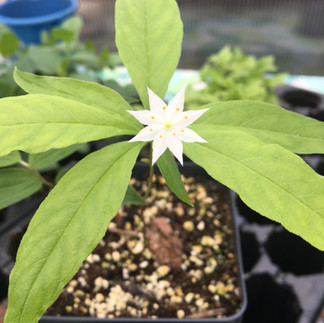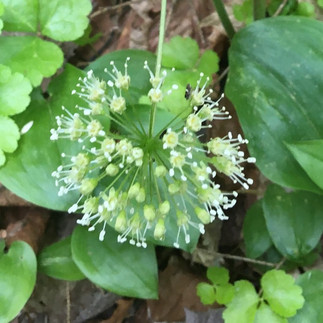State of the Nursery: Native Plants in February
- Michelle
- Feb 26
- 7 min read
The end of February nears. The sun has returned, at least occasionally, and your thoughts turn naturally to plants, of course. What's going on at your local native plant nursery, you wonder... Perhaps you picture the cozy heated greenhouse from the Frosty the Snowman animated classic, stuffed to the brim with happy flowering plants and warm enough to melt winter out of existence?
Someone must have that image in their mind, because I recently got an order and the person specified that they didn't want to pick up their plants now. Not a problem! The plants we overwintered are tucked deep in a snowbank. Even if her order was from our overwintered stock, there is no way I could find it before snowmelt. Then the plants would need several weeks in the greenhouse to wake up and break dormancy.
Her plants might not even be out there, though. Many of our plants will be grown fresh from seed this spring, but the seeds are still chilling in bags of moist dirt. This cold rest period simulates winter conditions and triggers the seeds to sprout when we start pulling them out next week. However, they are still months from becoming deliverable plants! We haven't even finished stratifying some of our seeds yet. Chances are, the plants you order for spring are just a twinkle in the seed bag.
So should I wait to order?
If you know what you want, please don't wait to order. Ordering early will get you your order sooner in the spring; it helps us plan and prioritize; and it ensures we won't sell out of your must-haves.
Get your native plants earlier:
If you wait, your order will be buried in the thousands of plants that we have to get out the door for our spring rush. You may not get your order for many weeks. Order now, or as soon as you know what you want. Don't worry: we won't try and get you to pick up plants now. Even if we could find your order under the snow, we don't start filling orders until May when things have broken dormancy and we can verify that we are putting out healthy plants.
Help us make your plants a priority:
Ordering early helps us plan what seeds to prioritize. Most seeds need at least 30 days of cold stratification before they will germinate. We try and guess what people will want, but early orders help us determine which seeds to pull out first and which ones to pot up into plug flats first. If no one has ordered a particular plant when we start potting things up in April, it will languish in the seed tray until we have time to get to it after the other orders are growing.
Don't miss out on your wishlist plants
Sometimes supplies are limited. Some seeds need 120 days of stratification. We already have those in cold storage. By March it will be too late to start another batch for this year. Other plants like some woodland species are finicky or slow growers, and we rarely have more than a few. Ordering now reserves your special plants. If you decide you want more plants later, you can always place a second order.
What does "In Stock" mean?
At this time of year (late winter), "In Stock" is an imaginary number. We do have more than 25,000 plants, mostly in plug flats, overwintering in our several storage yards. However, we will not know how many survive winter storage for several more months. In years with little snow, freeze/thaw cycles can tear up the crowns. In years when the protective snow is deep, voles are free to test our defenses, and they find native plant roots very tasty. We will know what survived when the snow melts for good. But, never fear, by spring we will already be growing almost all of our species from seed. Our overwintered stock will not fill all of our orders for the year, no matter how many survive, so we will start pulling seeds out of stratification in March and the growing season will begin. At this time of year, the designation of "In Stock" on the website just means we are overwintering or growing that species this year and we expect it will be ready to go in the May/June timeframe. Later in the season," In Stock" means we have the plants at least in plug flats; it may still take some time to get the plants potted into quart pots and brought up to deliverable size.
What does "Out of Stock" mean?
"Out of Stock" means we are not sure if we will have that plant for spring rush or the foreseeable future (Errr... it might also mean I haven't had time to update the inventory). For some things, like Starflower, we have very few, and we need to see how many survive or are able to be divided before we put them in stock in spring. For some things, we may not have had access to seed last year, or germination is uncertain, or deer ate our seed stock, or voles ate our wintering flats, or our inventory is otherwise constrained. We may very well have those plants in stock later in the season. Click the "Notify When Available" button on the product page and you will get an automatic email as soon as the plant is back in stock.
When will I get my plants?
There it is. The million dollar question. The best answer I can give is the exact date your order will be filled depends on the weather that spring, what you ordered, and how many people are ahead of you in the queue. In general, we fill our January/February orders in mid to late May. March/April orders are typically late May to early June. If you wait until May to order, we will probably not be able to get you your plants until late June or even early July when the dust settles from the spring rush.
Factors that affect when your order is ready
Number of people and plant sales ahead of you in the queue. We fill orders first-come, first served, and we reserve stock to meet our large plant sale commitments. Order early for best results, but your patience is appreciated. Native plants typically take 3 or more years to reach maturity. A couple of weeks one way or another will not affect your results.
Complexity of your order: With the number of plants and types of plants we offer, we can't have everything ready at the same time in the spring. Some won't germinate or break dormancy until the conditions are right. Some we simply can't get to while we deal with other species. We will contact you to pick up your order when most or all of your plants are within a week or two of being ready. If your order is larger, we may be able to offer a partial pickup date while we wait for your other plants to finish up.
Garden Kits: We love Garden Kits! And with the number that are ordered each season, apparently so do you! They are a great and economical way to get a variety of plants into your space. They also are a way for you to hit the easy button and let us put together a collection of plants that work well together or meet your gardening goals. However, garden kits generally contain 12-13 different species of plants. It takes time to get all of those species ready. Because they take quite a bit of time to assemble, garden kits get made in batches during the spring rush. We get the main kits, like Wildflower, Butterfly, and Sandy Soil, done before the Marquette Conservation District plant sale in early June. The niche kits, like the Rock Garden Kit (pun intended), tend to get made in mid-June. Again, ordering early helps us select which kits to make first to fill the maximum number of orders in a timely fashion.
We want you to be happy: Trust us! We want to fill your order and free up the mental and physical space in the nursery every bit as much as you want those plants to fill your mental and physical space at home. We work incredibly hard during the rush to fill orders as fast as we can, while still meeting our larger deliverables. As soon as we are able to get your plants to you, we will. If you haven't heard from us, we haven't had a chance to get to your order yet or we are waiting on a slow-poke plant.
Is it okay to plant in June, July, or later?
Absolutely! The idea that we need to have everything planted by early June is something drummed into us by conventional gardening culture. It is a great rule of thumb for tomatoes, especially in our region of constrained growing season, but it doesn't hold true for native perennials. Many native plants don't flower much until they are about three years old. Before then they are devoting most of their energy to growing roots, staking a claim in their territory, and building relationships with the soil and surrounding plants. June/July/August of their first year, or even their second, is still a time of vigorous growth, at least in the Upper Peninsula. Often, our plants are at their peak in July, ready to bust out of their pots and into you soil. We sell plants all season long. We have a full slate of plant sales scheduled for July and August. There is nothing wrong with planting perennial plants in summer. You will have to water them during drought the same as you would a plant you planted in May. Don't want to water as much? Shoot for planting at the end of August when the risk of drought decreases.
Somewhere in late August the plants slow their top growth and start to focus solely on roots. August and September, even into October or November in some years, is the best time to plant because that root energy can happen in your soil, instead of constrained by a pot. Fall-planted plants will be fueled up and ready to go in spring before you can even work the ground. In addition, soil moisture is increasing in the fall and the risk of drought lessens. What to see more? Check out my post on why fall is the best time to plant.

You've convinced me. What if I don't want to plant in the spring?
Go ahead and order early to reserve your plants. Let us know in the notes section during checkout or by email when you are planning to plant. We will have your plants ready for you at the appointed time!
Will you be in my town this summer?
Probably! We have sales and markets scheduled in Marquette (several), Houghton, Escanaba, Munising, Brimley, Ironwood, Watersmeet, Iron Mountain, Manistique, and Hessel. We are working on Calumet (fall), Negaunee (summer), and Crystal Falls. We're bringing the plants; check our Happenings page for details!

Watch for our list of plant sales coming to your email soon!
As always, thank you for planting native plants.





















Elevate your brand with expert digital marketing services designed to increase visibility generate leads and grow your business effectively